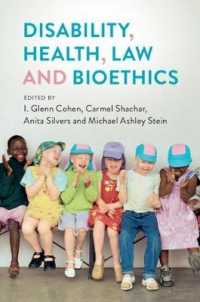Full Description
What Does Developmentally Appropriate Practice Look Like in an Infant and Toddler Program?
If you've ever wondered how effective teachers actually do DAP with very young children, this is the book for you. Here, you can peek into classrooms to see teachers making intentional decisions in key areas of practice. These areas form the six guidelines for DAP in action:
1. Building a community where everyone is welcomed and supported to grow
2. Facilitating reciprocal partnerships with families
3. Observing, assessing, and documenting children's development and learning
4. Using teaching strategies that enhance learning for each child
5. Implementing curriculum tied to meaningful learning goals
6. Demonstrating professionalism
You'll discover
More about what each guideline means for working with infants and toddlers and their families
Chapters that showcase articles from Young Children and NAEYC book excerpts—plus brand-new content—illustrating excellent teaching strategies related to each guideline
Examples you can model, adapt, and implement in your own practice
Enrich and deepen your teaching, and enable children's learning to flourish!
Contents
About the Editors
Focus on Developmentally Appropriate Practice: Equitable and Joyful Learning Book Series
Developmentally Appropriate Practice: An Introduction
Developmentally Appropriate Practice with Infants and Toddlers
Part 1: Creating a Caring, Equitable Community of Learners
Chapter 1: Caring Relationships: The Heart of Early Brain Development | J. Ronald Lally and Peter L. Mangione
Chapter 2: Care and Equity in Toddler Classrooms: Practices for Creating, Sustaining, and Empowering Community | Nana E. Appiah-Korang and Abigail P. Gulden
Chapter 3: Cultivating Positive Relationships and Physical Environments to Support Emotional Well-Being | Iheoma U. Iruka
Chapter 4: The First Step for Addressing Bias in Infant and Toddler Programs | Sarah MacLaughlin
Part 2: Engaging in Reciprocal Partnerships with Families and Fostering Community Connections
Chapter 5: Creating Partnerships to Support Families of Infants and Toddlers | Kelly Ramsey
Chapter 6: Engaging with Families to Individualize Teaching | Marie L. Masterson
Chapter 7: Facilitating a Child's Transition from Home to Program Through the Use of Cultural Caring Routines | Josephine Ahmadein
Chapter 8: Speaking Out: Supporting Families in Advocacy | Kristen Johnson and Amanda Perez
Part 3: Observing, Documenting, and Assessing Children's Development and Learning
Chapter 9: Bringing Observation and Documentation to Life in Infant and Toddler Settings | Rebecca Parlakian
Chapter 10: Observation and Documentation: Both Art and Science | Malori‑Naomi Wallace‑Wyche
Chapter 11: Using a Child-Centered Approach to Shift from a Deficit Mindset | Julia Luckenbill, Aarti Subramaniam, and Janet Thompson
Chapter 12: Empowering Infants' and Toddlers' Learning Through Scaffolding | Linda Groves Gillespie and Jan D. Greenberg
Chapter 13: What Babies Ask of Us: Contexts to Support Learning About Self and Other | Mary Jane Maguire-Fong
Part 4: Teaching to Enhance Each Child's Development and Learning
Chapter 14: What to Teach Before Talking: Developing Communication Skills Across Home and Early Learning Contexts | Mollie Romano, Jennifer A. Brown, Christan Coogle, Jennifer R. Ottley, and Emily M. Rose
Chapter 15: The Power of Pause: Moments of Silence and Early Emotional and Language Development | Nodelyn Abayan
Chapter 16: Strengthening Infant and Toddler Teaching with Explicit Language Skills | Allyson Dean and Linda Groves Gillespie
Chapter 17: "You're Okay" May Not Be Okay: Using Emotion Language to Promote Toddlers' Social and Emotional Development | Elizabeth K. King
Chapter 18: We Put Paper on the Floor: Supporting the Emergent Literacy Skills of Infants and Toddlers | Dilshad Tolliver
Part 5: Planning and Implementing an Engaging Curriculum to Achieve Meaningful Goals
Chapter 19: Curriculum Considerations for Multilingual Infants and Toddlers | Irasema Salinas-González, Iliana Alanís, and María G. Arreguín
Chapter 20: When in Doubt, Reach Out: Teaming Strategies for Inclusive Settings | Christine M. Spence, Deserai Miller, Catherine Corr, Rosa Milagros Santos, and Brandie Bentley
Chapter 21: Exploring Outdoors: First Learning Experiences in Nature | Mary Benson McMullen and Dylan Brody
Chapter 22: Using the Environment and Materials as Curriculum for Promoting Exploration of Cause and Effect | Guadalupe Rivas Jer
Chapter 23: Infant and Toddler STEAM: Supporting Interdisciplinary Experiences with Our Youngest Learners | Eric Bucher and Stephanie Pindra
Part 6: Demonstrating Professionalism as an Early Childhood Educator
Chapter 24: Nurturing Your Professional Appetite: Preparing Your Professional Development Path | Christy Brown‑John
Chapter 25: Creating Learning Stories in the Context of Inquiry Groups | Isauro M. Escamilla, Linda R. Kroll, Daniel R. Meier, and Annie White
Chapter 26: Thinking of Yourself as a Professional | Nicole Lazarte
Chapter 27: Advocacy in Action: Stepping Up to Make an Impact | Maria Estlund
Index








